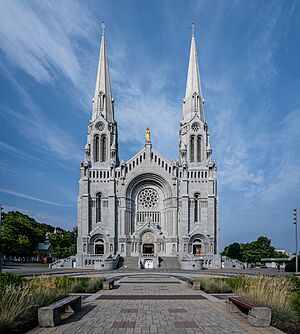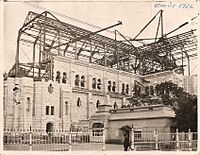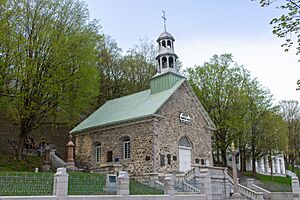Basilica of Sainte-Anne-de-Beaupré facts for kids
Quick facts for kids Basilica of Sainte-Anne-de-Beaupré |
|
|---|---|
|
Basilique Sainte-Anne-de-Beaupré
|
|

Basilica of Sainte-Anne-de-Beaupré
|
|
| 47°01′27″N 70°55′42″W / 47.02417°N 70.92833°W | |
| Location | Sainte-Anne-de-Beaupré, Quebec |
| Country | Canada |
| Denomination | Catholic Church |
| History | |
| Status | Basilica |
| Architecture | |
| Functional status | Active |
| Architectural type | Norman-Gothic, Romanesque Revival |
| Completed | 1946 |
| Specifications | |
| Length | 105 m (344 ft) |
| Width | 48 m (157 ft) |
| Spire height | 91 m (299 ft) |
| Administration | |
| Archdiocese | |
| Type: | Recognized heritage immovable |
| Designated: | 2001 |
| Reference #: | 93392 |
The Basilica of Sainte-Anne-de-Beaupré is a very special church located along the Saint Lawrence River in Quebec, Canada. It's about 30 kilometers (19 miles) east of Quebec City. This basilica is one of Canada's six national shrines. Many people believe that miracles of healing the sick and disabled have happened here.
It is an important Catholic holy place. About half a million pilgrims visit it every year. Many come around July 26, which is the feast day of Saint Anne. Saint Anne is known as the patron saint of sailors.
Contents
History of the Basilica
The Basilica of Sainte-Anne-de-Beaupré began as a small shrine to honor Saint Anne. In 1658, a settler named Étienne de Lessard gave land to the Catholic Church. This land was used to build a chapel. This chapel eventually became the site of the large basilica we see today.
The chapel was built for the new settlers in the area. It also housed a special statue of Saint Anne. The first reported miracle happened while the shrine was being built. A man named Louis Guimont, who suffered from rheumatism, helped with the construction. After he placed three stones on the shrine's foundation, he was completely cured.
Growth and Popularity
After Louis Guimont's healing, many other people reported being cured. The shrine quickly became very popular. Many pilgrims came hoping for a miracle. Even important people, like Anne of Austria, who was the Queen of France, supported the shrine from afar.
Because so many people visited, the building was made larger several times. In the late 1800s, a basilica was built around the original shrine. The first basilica opened in 1876.
Fire and Rebuilding
Sadly, this first basilica was destroyed in a fire on March 29, 1922. The current basilica was then built on the same spot. Construction started in 1923 and continued until 1931. Architects Maxime Roisin, Louis N. Audet, and Joseph-Égilde-Césaire Daoust worked together on the design.
After the Great Depression ended, work on the inside of the basilica started again in 1937. The entire building was finally finished in 1946.
Miracles and Memorials
Today, pilgrims still come from all over Canada and the United States. Many believe that miracles continue to happen at the basilica. Near the entrance, there are two pillars filled with crutches, canes, and braces. These items were left by pilgrims who say they were healed at the basilica.
Next to the basilica, there is a wooded hillside. It has a memorial chapel and a Way of the Cross. The Way of the Cross features life-sized statues showing the Stations of the Cross. Higher up the hill, you can find the Convent of the Redemptoristines. This building was built in 1906 and recognized as a historic site in 2001.
Architecture and Art
The Basilica of Sainte-Anne-de-Beaupré is a very large building. It is 105 meters (344 feet) long and 48 meters (157 feet) wide. The transept, which is the part that crosses the main body of the church, is 61 meters (200 feet) wide. The steeple, which is the tall pointed tower, reaches 91 meters (299 feet) high.
Inside the Basilica
The inside of the basilica is filled with beautiful art. Joseph-Émile Brunet designed 24 special stone carvings called capitals in 1948. These carvings show 52 religious scenes from the life of Jesus.
Brunet also created 14 "Stations of the Cross" that line the walls. He sculpted stone statues of Saint Anne and other Saints at the entrance. In addition, he made the fountain outside the basilica. Inside, you can see his 7-foot-6-inch tall stone sculptures of Saint "Marie de L'Incarnation", "Saint Joseph", "The Virgin with Jesus", Saint "François de Laval", and "St. Joachim". He also created a bronze sculpture of Saint Kateri Tekakwitha, which is 6 feet 4 inches tall.
See also
 In Spanish: Basílica de Sainte-Anne-de-Beaupré para niños
In Spanish: Basílica de Sainte-Anne-de-Beaupré para niños





